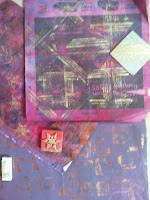Trying to interpret colour onto a variety of papers with my acrylic colour recipes I reread the instructions and appreciated I should have been using inks.
With some inkjet refills to hand – they were no longer of use with ‘new’ printer - I set out to replicate the colours, see ref 10.
The ink absorbed very quickly into the paper and the amount of papers being coloured soon made the workspace chaotic. It took several attempts, a range of papers emerged, some of which looked equally chaotic! Against the first colour mixing with acrylic where the results were too thick the inks looked thin. The solution – to over print inks with acrylic paints as I had used up all my inks. The reason for revisiting this part of the exercise can be seen in the star and cross shapes in ref 11.
A 3 sheet
Printing blocks were made up using a rubber, on both sides and lino cuts. I also had string and card blocks of stars to hand as seen in ref 2. and other rubber stamps See ref 12a and b for printing blocks and samples of prints and papers.
A 3 sheet
Star and cross shapes, see ref 11, were made and whilst pleased with some of the ideas that came when linking shapes I was becoming increasingly frustrated by the quality of my coloured papers and the cutting of some of my shapes! I resolved to buy the book Colour on Paper and Fabric by Ruth Issett to double check my techniques.
I would make revisits to the colour palette in the following days as I was unhappy with recipe book samples and particularly unhappy with the greens made… the ultimate answer appeared to be to experiment with the two tones of blue and the two tones of yellow mixing them into one base colour before introducing white or black. In order to allow the coloured papers to have more depth a layering process built up paint rather than making thick paint to start with. I used white or neutral cotton muslin, calico to ‘mop up’ the colour thereby hoping to achieve empathy between paper and fabric colours.
Some of the papers that would eventually be used for Chapter 3 and 4 are in Ref 18 seen below.
NB all images are A4 unless otherwise stated


















































